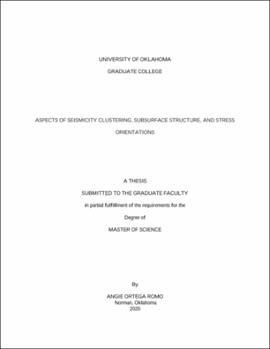| dc.description.abstract | I study aspects of seismicity clustering, subsurface structures and stress orientations by analyzing seismicity at two of the most seismically active regions in the USA (Hawaii and Central USA). The notable volcanic, seismic, and collapsing activities at the summit of Kilauea volcano in 2018, provided a significant opportunity to observe and quantify naturally occurring earthquake clusters and their characteristics. I perform a spatiotemporal clustering analysis of the high-resolution earthquake catalog presented by Shelly and Thelen (2019) following the nearest neighbor workflow in Cheng and Chen (2018). We identify two modes (M1 and M2) of naturally occurring earthquake clusters. M1 focuses on restricted time and distance separation with: η=0.0316,R=0.0562 km,T=0.1 day. It consists of 45 clusters (20+ events). M1 clusters do not show clear temporal correlation with collapsing events (M≥5) and are found as isolated patches of seismicity off the main crater. M2 focuses on time separation with η=0.0316,R=6.3096 km,T=0.1 day finding 42 clusters (20+ events). M2 clusters can be defined as a seismicity cycles, where the collapsing events (M5.2 – M5.4) mark the end of the cycle. M2 clusters identify the precursory activities leading up to major collapsing events and corresponds to the deformation activity (tilt rate) at the summit of Kilauea volcano. On the other hand, the central USA has experienced significant seismicity rate fluctuations over the last decade (Schoenball & Ellsworth, 2017). A key question to better understand the triggering mechanism is the relative depth to basement and injection layer. However, determining absolute depth is challenging due to station coverage and imperfect 1D velocity models. In this study, I analyze crustal reverberations (reflection within the upper sedimentary layer) to improve earthquake depths estimation for the Cushing fault zone sequence. I use waveform cross-correlation to group events into different similar event clusters, then I obtain double difference relative locations and examine waveform signatures of different clusters. Upon careful examination, I find that events originated at different depth have different amplitudes of reverberations. For Cushing sequence, I identify a narrow layer at shallow depth, likely representative of more weathered portion of the top of crystalline basement. To execute a regional spatial analysis of fast polarization directions (ɸ) in the central U.S.A. I use the shear wave splitting (SWS) technique to measure SWS parameters (fast direction [ɸ] and delay time [dt]). I use 33,367 local earthquakes recorded from 2010 to 2019 and the automated SWS software MFAST (Savage et al., 2010) to calculate SWS parameters. I successfully calculate 524,395 splits. The high-quality measurements provide a complete localized and regional dataset of SWS measurements for the Central U.S.A. All stations in this study present two directions of fast polarization, primary (ɸpri) and secondary (ɸsec). The presence of these ɸsec is potentially caused by local stress perturbations and shear-fabric alignments. At the regional level, either ɸpri or ɸsec correlate with the maximum stress orientation (σmax) in the region. However, many sub-regions show a clear deviation between ɸ and σmax directions. These discrepancies are potentially caused by local structures. | en_US |

